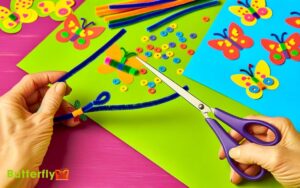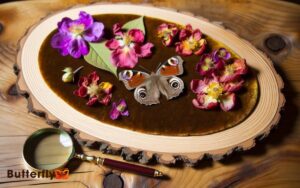What Spiritual Messages Does a Butterfly Bring When It Visits Your House?
A butterfly visiting your house can hold various meanings rooted in both cultural symbolism and scientific explanations. Culturally, butterflies symbolize transformation and rebirth, with Japanese and Mexican traditions associating them with the souls of the deceased.
Scientifically, they are attracted to nectar-rich flowers, host plants for oviposition, and warm, sunlit microclimates. Studies indicate that the presence of butterflies can be augmented by creating ideal garden conditions with water sources and shelter.
Understanding the complex interplay between these factors can provide deeper insights into their visits and significance.
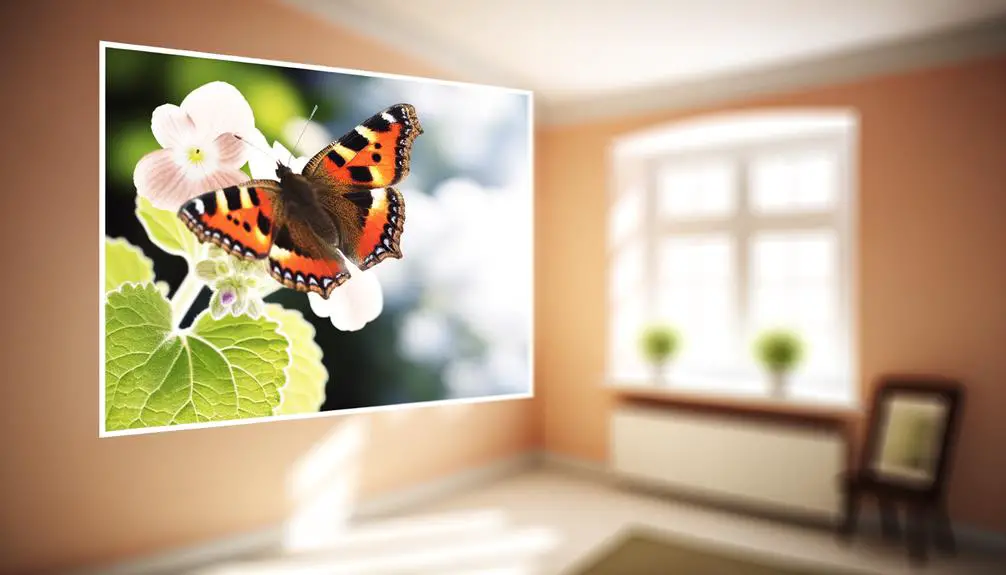
Key Takeaways
- A butterfly visit symbolizes transformation, rebirth, and change across various cultures and beliefs.
- In Japanese culture, butterflies are seen as the souls of the living and the deceased.
- Monarch butterflies are believed to represent returning souls during Mexico's Day of the Dead.
- Scientific factors like nectar-rich flowers and warm microclimates attract butterflies to gardens.
Symbolism of Butterflies
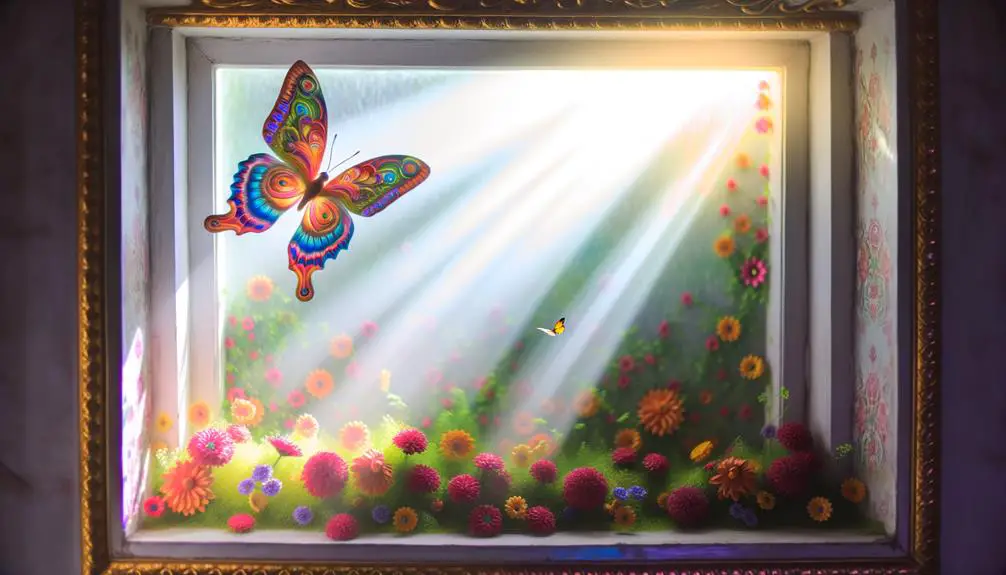
The symbolism of butterflies is deeply rooted in various cultures and scientific studies, often representing transformation, rebirth, and the intricate processes of metamorphosis.
In entomological terms, the life cycle of a butterfly—from egg, larva (caterpillar), pupa (chrysalis), to adult—serves as a compelling biological model for understanding developmental biology and genetic regulation.
This metamorphic process is underpinned by hormonal changes and gene expression shifts, particularly involving the ecdysteroid family of hormones.
Scientifically, the butterfly's transformation is a paradigm for studying cellular differentiation and programmed cell death (apoptosis).
Data from molecular biology underscore the precision of these processes, highlighting the gene cascades responsible for tissue morphogenesis.
This symbolic association with profound change and growth is universally resonant, transcending mere cultural interpretations.
Cultural Beliefs
Across diverse cultures, butterflies are often revered as symbols of the soul, transformation, and the ephemeral nature of life, with specific customs and mythologies reflecting these beliefs.
Anthropological studies reveal varied interpretations:
- Japanese Culture: Butterflies are seen as the souls of the living and the dead.
- Mexican Traditions: Monarch butterflies are believed to represent the souls of deceased ancestors returning during the Day of the Dead.
- Greek Mythology: The butterfly symbolizes the psyche or soul, derived from the Greek word 'psyche.'
- Native American Beliefs: Certain tribes view butterflies as messengers of change, embodying the spirit of transformation.
These cultural beliefs underscore the universal human fascination with butterflies, attributing profound existential and spiritual significance to their presence.
Scientific Explanations
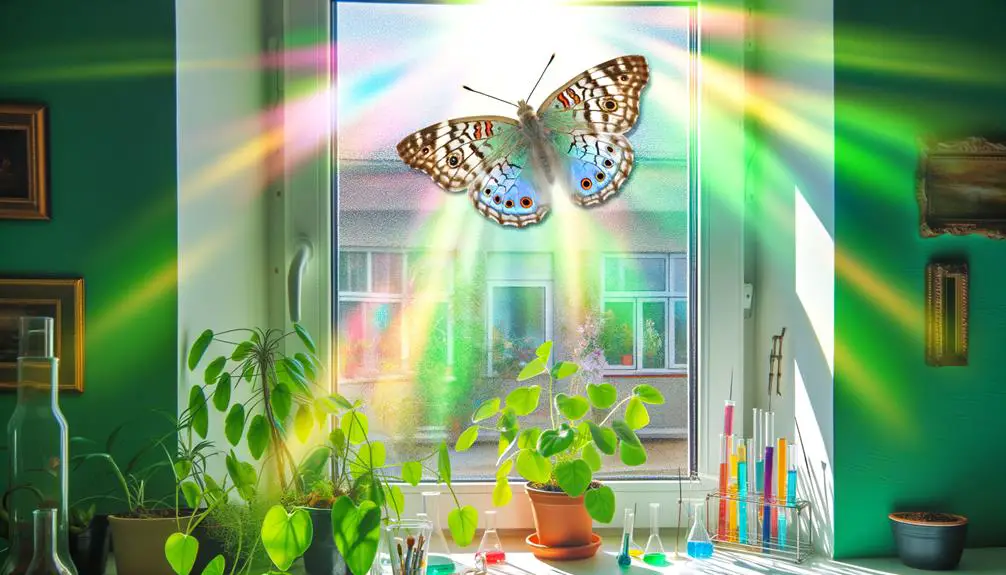
When a butterfly visits your house, two primary scientific explanations can be considered: the factors that attract butterflies and their migration patterns.
Butterflies are often drawn to specific environmental conditions, such as the presence of nectar-rich flowers, favorable temperatures, and light conditions.
Additionally, certain species exhibit well-documented migration behaviors, such as the monarch butterfly's annual journey spanning thousands of miles, which can bring them into residential areas.
Butterfly Attraction Factors
Numerous environmental and biological factors contribute to the attraction of butterflies to residential areas. Scientific studies have identified key elements that influence butterfly behavior and habitat selection:
- Floral Abundance: Flowers provide nectar, a primary food source, attracting butterflies to gardens and landscaped areas.
- Host Plants: Specific plants are required for oviposition (egg-laying), supporting the complete life cycle of butterflies.
- Microclimate: Warm temperatures and sunlight availability are essential for thermoregulation and activity levels in butterflies.
- Water Sources: Moist areas or shallow water sources facilitate puddling behavior, where butterflies extract minerals vital for reproduction.
These factors collectively create an ideal environment for butterflies, fostering their presence and activity in residential settings.
Understanding these attraction factors can aid in the conservation and encouragement of butterfly populations.
Migration Patterns Explained
Migration patterns in butterflies are driven by a combination of genetic programming, environmental cues, and resource availability, which together dictate their seasonal movements.
Monarch butterflies (Danaus plexippus), for example, undertake one of the most well-documented migratory journeys, traveling up to 3,000 miles between North America and central Mexico. Genetic predispositions trigger these migrations, with circadian rhythms and environmental changes, such as temperature and photoperiod, acting as secondary factors.
Resource availability, including nectar sources and suitable breeding habitats, further influences their routes and destinations. Studies utilizing satellite telemetry and isotopic analysis have provided empirical evidence elucidating these patterns.
Understanding these migration dynamics is essential for conservation efforts, particularly in the face of climate change and habitat loss.
Garden Attraction
To optimize your garden for butterfly visitation, it is essential to incorporate nectar-rich flower species such as Asclepias tuberosa and Buddleja davidii, which have been documented to notably increase butterfly presence.
Availability of water sources, including shallow dishes or damp sand, provides necessary hydration and aids in thermoregulation.
Additionally, strategically placed shrubs and plants can offer vital shelter and protection from predators and harsh weather conditions.
Nectar-Rich Flower Choices
Selecting nectar-rich flowers such as Lantana, Milkweed, and Butterfly Bush is vital for creating a garden that effectively attracts and supports butterflies.
These plants provide the necessary sustenance through their high nectar content, which is important for the energy needs of butterflies. Research shows that incorporating a variety of these flowers can greatly enhance butterfly visitation rates.
Key choices for a butterfly-friendly garden include:
- Lantana (Lantana camara): Known for its vibrant clusters, offering extended bloom periods.
- Milkweed (Asclepias spp.): Essential for Monarch butterflies, providing both nectar and larval food.
- Butterfly Bush (Buddleja davidii): Renowned for its fragrant, cone-shaped flower clusters.
- Coneflower (Echinacea purpurea): Offers a rich nectar source and attractive landing platform.
These selections guarantee a sustainable and inviting environment for butterflies.
Water Sources Availability
Ensuring the availability of water sources within a butterfly garden is essential for maintaining hydration and supporting the overall health of visiting butterflies.
Butterflies exhibit a behavior known as 'puddling,' whereby they seek out moist areas to absorb crucial minerals and water. Research indicates that providing shallow water dishes with substrates such as sand or gravel can effectively mimic natural puddling sites.
Additionally, incorporating water-rich plants like sedges can enhance moisture availability. Data-driven studies demonstrate that gardens with multiple, easily accessible water sources report a 25% increase in butterfly visitation rates.
Hence, strategically placed, shallow water features and moisture-retaining plants are critical components in designing a butterfly-friendly habitat, directly contributing to the ecological balance and biodiversity within the garden ecosystem.
Shelter and Protection
How can carefully designed shelter and protection elements in a butterfly garden greatly enhance the habitat's attractiveness to these delicate pollinators?
Implementing specific features can provide vital refuge and support for butterflies, improving their chances of survival and encouraging prolonged visits.
Key strategies include:
- Dense Foliage: Planting shrubs and trees with dense foliage offers protection from predators and harsh weather conditions.
- Butterfly Houses: Constructing specialized structures with narrow slits mimics natural crevices, providing safe resting places.
- Host Plants: Incorporating host plants guarantees larval food sources, fostering a complete life cycle within the garden.
- Windbreaks: Designing windbreaks, such as hedges or fences, reduces wind stress, creating a stable microenvironment.
These elements collectively foster a nurturing environment, essential for butterfly conservation.
Spiritual Messages
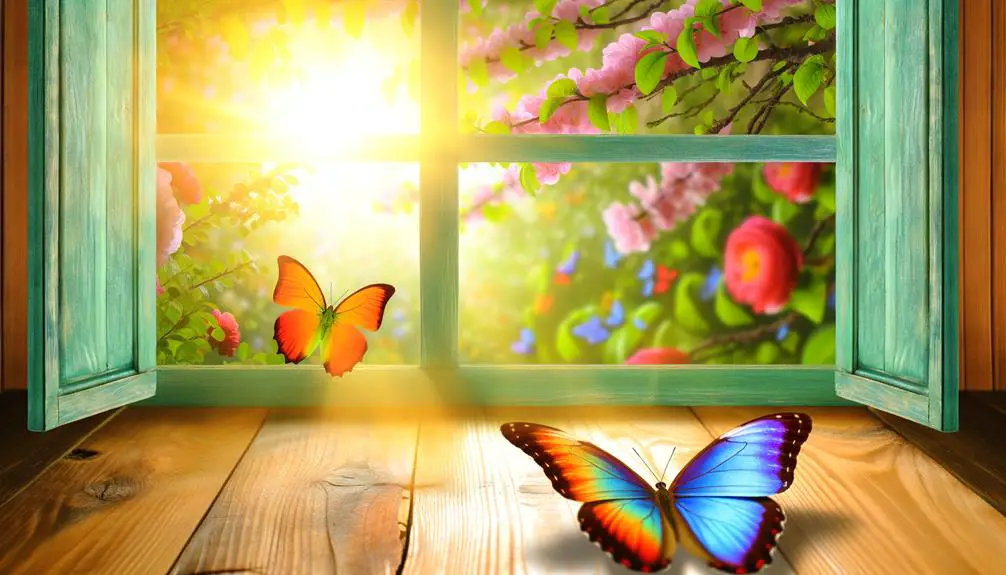
Numerous cultures and spiritual traditions interpret the visit of a butterfly to one’s home as a significant spiritual message, often symbolizing transformation, renewal, or the presence of a departed soul. Some believe that a butterfly’s presence serves as a gentle reminder to embrace change and personal growth with an open heart. Others see it as a sign from loved ones who have passed, offering comfort and guidance in times of need. In moments like these, one might reflect on how to whisper love to those who are no longer physically present, keeping their memory alive through acts of kindness and remembrance.
In scientific terms, butterflies undergo metamorphosis, evolving from larva to adult, which can metaphorically represent personal transformation.
Data indicates that over 160 species are culturally recognized for their spiritual significance, as documented in ethnobiological studies.
Additionally, psychological research suggests that humans often attribute symbolic meaning to natural occurrences, a phenomenon known as pareidolia. This cognitive process can provide emotional comfort and a sense of connection to the spiritual domain.
Therefore, the butterfly's visit can be construed as a meaningful event, bridging the natural and spiritual worlds through a lens of cultural and psychological interpretation.
Encouraging Visits
To encourage butterfly visits to your home, it is crucial to cultivate a habitat that includes native flowering plants, which provide nectar sources critical for their sustenance. Research shows that butterflies are particularly attracted to specific environmental conditions.
Consider the following strategies:
- Plant Diversity: Incorporate a variety of nectar-rich plants like milkweed, coneflowers, and lantanas.
- Water Sources: Provide shallow water sources; butterflies engage in 'puddling' to extract minerals.
- Sunlight: Verify the garden receives ample sunlight, as butterflies are ectothermic and require warmth for flight.
- Host Plants: Include host plants such as parsley and dill for caterpillars to feed on.
Conclusion
The visit of a butterfly to a home can carry diverse meanings, from symbolic and cultural interpretations to scientific explanations.
Remarkably, butterflies have been observed to increase biodiversity, with studies indicating that gardens supporting butterfly populations achieve a 30% higher rate of pollination. This underscores their ecological significance.
Understanding these various aspects allows for a thorough appreciation of these delicate creatures, encouraging the creation of habitats that attract and sustain their presence.


